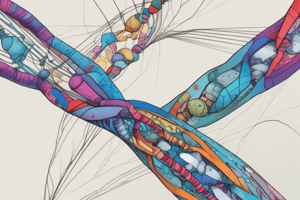Podcast
Questions and Answers
What role do Exonic Splicing Enhancers (ESEs) play in splicing?
What role do Exonic Splicing Enhancers (ESEs) play in splicing?
- They inhibit splicing at nearby splice junctions.
- They promote splicing at nearby splice junctions. (correct)
- They bind directly to U2 snRNP.
- They are part of the spliceosome complex.
How do SR proteins assist in the splicing process?
How do SR proteins assist in the splicing process?
- By marking exons and promoting recognition of splice junctions. (correct)
- By binding to intronic sequences exclusively.
- By inhibiting the binding of U1 snRNP.
- By directly participating in the cleavage of pre-mRNA.
Which proteins are responsible for binding near the 3' splice site?
Which proteins are responsible for binding near the 3' splice site?
- SR proteins and ESEs.
- U2 snRNP and U1 snRNP.
- SR proteins and U1 snRNP.
- U2AF65 and U2AF35. (correct)
What is the primary benefit of alternative splicing?
What is the primary benefit of alternative splicing?
Which cell type includes exons that encode 'sticky' protein residues from the fibronectin gene?
Which cell type includes exons that encode 'sticky' protein residues from the fibronectin gene?
What characterizes the splicing of the calcium-activated potassium channel pre-mRNA?
What characterizes the splicing of the calcium-activated potassium channel pre-mRNA?
What is the function of U1 snRNP in RNA splicing?
What is the function of U1 snRNP in RNA splicing?
What type of sequences influence splicing but are distinct from splice sites?
What type of sequences influence splicing but are distinct from splice sites?
Flashcards
Sequences near splice sites
Sequences near splice sites
Short DNA sequences surrounding splice junctions that influence splicing, even though they don't directly define the splice sites themselves.
RNA-binding proteins
RNA-binding proteins
Proteins that bind to specific sequences near splice sites, either promoting or inhibiting splicing.
Exonic splicing enhancers (ESEs)
Exonic splicing enhancers (ESEs)
Sequences found within exons that promote splicing at nearby splice junctions. They are bound by SR proteins.
SR proteins
SR proteins
Signup and view all the flashcards
Alternative splicing
Alternative splicing
Signup and view all the flashcards
Increased coding capacity
Increased coding capacity
Signup and view all the flashcards
Cell type-specific splicing
Cell type-specific splicing
Signup and view all the flashcards
Example: Calcium channel in the ear
Example: Calcium channel in the ear
Signup and view all the flashcards
Study Notes
Protein Interactions in Splicing
- Proteins interact with U1 snRNP and U2 snRNP, binding to specific sequences near splice sites.
- Mutational analysis reveals that sequences around splice junctions and the branch point are crucial for splicing, distinct from the actual splice sites.
- RNA-binding proteins recognize short sequence motifs and either promote or inhibit splicing.
Exonic Splicing Enhancers (ESEs)
- Located within exons.
- Promote splicing at nearby splice junctions.
- Bound by SR proteins (RNA-binding proteins).
SR Proteins
- Contain RNA-binding motifs and protein-protein interaction domains.
- Directly interact with U1 snRNP and indirectly with U2 snRNP through factors near the 3' splice site.
- Bind to ESEs, marking exons and guiding the splicing machinery.
U2 snRNP and the 3' Splice Site
- U2 snRNP binds to the branch point, recruiting accessory factors.
- U2AF65 binds to the polypyrimidine stretch near the 3' splice site.
- U2AF35 binds to the RNA at the 3' splice site.
- These interactions guide the splicing machinery.
- SR proteins also participate in marking the exon to ensure proper splicing.
Alternative Splicing
- Definition: Multiple splicing patterns produce different mRNAs (and proteins) from a single pre-mRNA.
- Increases coding capacity of the genome.
- Allows a single gene to produce multiple protein isoforms.
Regulation of Alternative Splicing
- Can be cell type-specific, with different cell types splicing the same pre-mRNA in distinct ways.
- Example 1: Fibronectin gene - different cell types (fibroblasts/hepatocytes) include or exclude specific exons, producing tailored mRNAs. Fibroblasts have two exons encoding "sticky" proteins. Hepatocytes exclude these.
- Example 2: Calcium-activated potassium channel in the ear – allows for 576 splicing variations, each responding to specific calcium concentrations related to different sound frequencies. This adaptation is essential for hearing a wide range of frequencies.
Key Aspects of Alternative Splicing
- SR proteins mark exons and guide splicing machinery.
- This process increases protein diversity and tailors gene expression to specific cell types or functions.
- In some cases, a single gene can give rise to hundreds of isoforms, as shown by different isoforms of the calcium-activated potassium channel in the cochlea.
Studying That Suits You
Use AI to generate personalized quizzes and flashcards to suit your learning preferences.




